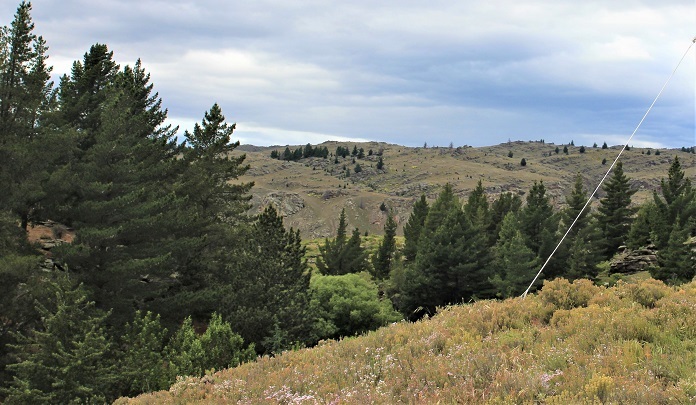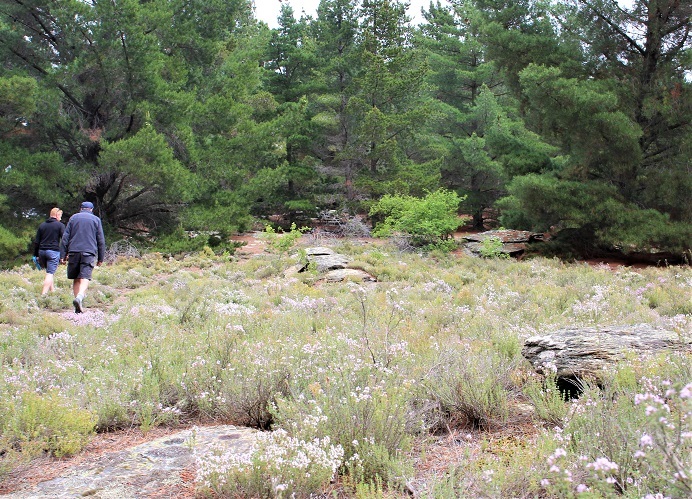Second Delay of Felling at Half Mile
Jill Herron
18 November 2021, 5:00 PM
 Half Mile residents Ken Churchill(left) and Chris Winter at a council reserve near Alexandra where pines are set to be felled.
Half Mile residents Ken Churchill(left) and Chris Winter at a council reserve near Alexandra where pines are set to be felled. Thirty Alexandra residents have put their names to a letter to the Central Otago District Council(CODC) expressing “desperate concern” over the planned felling of a 14ha stand of pines at the southern entrance to the town.
The residents were shocked to discover via local media on October 8 that the mature pines growing on a council-owned recreational reserve were to be felled within days, neighbour Ken Churchill said.
According to a CODC press release they had been identified as wilding pines and as a seed source for the spread of the invasive pest species, into surrounding hill country.
The work was delayed for some weeks after the residents contacted council to express their concerns and CODC began plans for landscaping options to be implemented after the trees were removed, he said.
A second delay has now occurred following more complaints, with residents now welcoming the Vincent Community Board’s move to allow more discussion prior to the felling.
“The Board is well aware of the community’s views regarding the sensitive issue of the Half Mile Reserve. We hear this loud and clear,” chairman Martin McPherson said.
During a public-excluded part of its monthly meeting this week, the Board outlined its desire for council staff to discuss the matter with the wider community and for people to be given the opportunity to provide input.
They acknowledged council’s responsibility to control wilding pines at the Half Mile, Lower Manorburn Dam, Alexandra Airport and Boot Hill but said the Board had a responsibility to the community to listen to concerns and views on the Half Mile, the restoration proposal, costings and timings of the operation, before any felling occurred.
Mr Churchill and neighbour Chris Winter said people had been deeply affected by the potential loss of what to them, was a well-loved and well-used shady walking area and a treasured part of the wider neighbourhood.
“There’s been a massive increase in Tui, Wood Pigeon and Bellbird in the last ten years. People collect cones, there’s trials bike people that hold competitions here. People walk their dogs and bring the grandkids. It’s Alexandra’s best kept secret,” Mr Winter said.
The birds mainly roosted in the forest after satisfying their culinary requirements in neighbours gardens, and skinks and lizards were also plentiful, he said. Work to reduce rabbit numbers through removal of briar, broom and gorse as food and shelter sources for the pests, had been working well.
Native species had been planted but some were not thriving due to the lack of water. All the work was done informally and there was no committee, rosters or rules.

A view from the Half Mile reserve looking south-east where wilding pines occur on hill country. At left are conifers growing at neighbouring Jolendale Park.
The pair had been asking older residents about the plot’s history and had been told original tree plantings were done by a group known as ‘The Men of Trees’ which included the late Jolyon Manning and the Schaumann family.
They believed the land had originally been gifted to the community to provide a greenbelt shelter for the entrance to town, similar to the large block of pines at Alexandra’s northern entrance.
Mr Manning also planted many conifers on his own neighbouring forest block which is now permanently protected by a QEII National Trust for Open Space covenant.
Their information contrasted to that of CODC who stated the Half Mile pines were not planted but “most likely self-seeded from nearby trees over the past 30-40 years”.
The Council envisaged that the reserve could be enhanced for a range of recreational activities after the trees were felled, as well as providing an attractive entrance into Alexandra.
“There is real potential for this reserve once the trees have been removed and the existing rock and archaeological features exposed. There are two pre-1900 water races, a sluice gulch remnant and the historic Alexandra-Roxburgh Road alignment, which could be featured,” CODC parks and recreation manager Gordon Bailey said.
He said Council will be working with the Central Otago Wilding Conifer Group with the CODC contribution to the Half Mile and Lower Manorburn reserves’ wilding removal set at around $25,000.
The balance will be funded by the Central Otago Wilding Conifer Trust using government funding.
The residents say they have no evidence that the block was not contributing to the spread of wilding pines which they acknowledged were a serious threat to landscapes.
They believed, however, from observations over many years that seeding rates were low and that many pines seen on bare hillsides across the Clutha River were likely seeded deliberately as shelter for stock or from any of a myriad of local seed sources.
In a letter from ‘Concerned Neighbours and Residents of Alexandra’, the group said they believed the felling would cause greater harm than good in environmental terms.
“It is the environmental impact that is of greater concern. Without these trees the current wildlife habitat will be lost resulting in significant ecological damage to our area.”

Chris Winter(left) and Ken Churchill walk through the undeveloped Half Mile reserve this week.
They welcomed the opportunity to attend a drop-in session - aimed at getting feedback on a draft concept plan to enhance the area post-felling - but principally in the hope that it would allow an opportunity for people to express the desire to keep the trees.
The session takes place on Monday, November 22, at the Alexandra Community Centre from 4pm to 6.30pm.
Mr McPherson also welcomed the opportunity to discuss council’s plan and encouraged the community to come and have its say “in a constructive manner to assist the board”.



